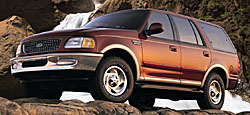![]() Ford's Approach
Ford's Approach
Similar to the success of NUMMI is Ford's effort to transform its corporate culture from a traditional hierarchical, economic model to a total quality management (TQM) model in the 1980s (Zeller & Gillis, 1995). TQM model put quality control, customer satisfaction, and work force satisfaction ahead of profit, and facilitates the implementation of information-intensive automation attempts. The benefits of adopting TQM can be seen in the development of the Mondeo/Contour, Ford's "world car." Maloney (1994) and reported that this new model was developed by close cooperation between designers, engineers, and assembly-line workers of the plant that builds the car. As a result, potential problems were sorted out before production began. Vasilash (1988) has also mentioned that earlier models of Taurus/Sable were likewise designed with the assembly process in mind. Another effect of TQM is that in automation, Ford not only emphasizes cost reduction and flexibility but also ergonomics, the improvement of the working environment (Maloney, 1994; Witt, 1995). As a result, workers suffered less fatigue and have higher morale. All the above examples should not be regarded as argument against automation. In fact, many Ford factories, such as the Tulsa Glass Plant in Oklahoma (Zarley, 1987) and the Chicago Assembly Plant in Illinois ("Ford's," 1986), are equipped with the most advanced robots, AGVs, and computer technologies. Ford's experience is just another proof that automation without careful consideration of corporate philosophy and management practice cannot guarantee success for a manufacturer.
Besides the issue of management, GM's speed of automation also turned out to be damaging to the company. GM simply wanted to do too much with too little time. As a result, managers and workers did not have enough time to master the latest technologies available. The chaos in Hamtramck during its first year clearly illustrate the danger of GM's "rushing ahead" strategy. In contrast, Ford and Chrysler moved more cautiously towards automation because they were at the edge of bankruptcy in the early 1980s. They simply did not have the ability to compete with GM in automation. As a result, these two companies' automation processes were more systematic and did not have GM's troubles.

Expedition 97'